Bethnal House
Cambridge Road, Bethnal Green, E2 0HL
Medical
dates:
Medical
character:
Mental (Licensed House)
In September 1800 Thomas
Warburton, the owner of Whitmore House asylum in Hoxton, bought Bethnal
House, a private madhouse in Bethnal Green.
The large, whitewashed, timber-framed mansion had been built in 1570 adjacent to the Poor's Land (or Green) by John Kirby, a rich merchant. Originally known as Bednall House, the project had nearly bankrupted him, and he was ridiculed by the villagers, who called it 'Kirby's Castle'. (The house also became associated with the ballad The Blind Beggar of Bethnal Green.) In 1727 Bethnal House was leased to Matthew Wright for £41 a year; he converted it into a private lunatic asylum - Wright's Madhouse. After his death his widow ran the asylum for a year until the lease was taken up by George Potter. The building was extended and acquired a new name - the White House.
Warburton lived next door to Bethnal House in a 3-storey 18th century mansion known as the Red House. He later moved to Hackney and Red House also became a private madhouse.
Both the White House and the Red House received paupers from many parts of London and its surrounding counties, sent to the asylum by their parishes at a weekly cost of 9s 6d to 10 shillings (48 to 50p). In 1811 the Red House (also known as Rhodes' House, after its superintendent) contained only 160 paupers, but this was because it was in the process of being rebuilt.
By 1815 conditions for the patients had become so scandalous that a Parliamentary Select Committee was convened. The Red House now contained 275 inmates, of whom 215 were paupers. The White House (also known as Talbot's House, after Matthew Talbot, its manager and superintendent), which had also been built for use as a family house, contained 360 inmates, of whom 230 were paupers. The beds were so crowded together that they almost touched. Sometimes two or three patients had to share a bed. Many slept naked in unheated rooms and most were chained to their beds. The straw they slept on was soiled and infested with vermin. The low-ceilinged rooms they slept in were steeped in the stench of their excrement.
By 1827 conditions of cruelty and neglect in the White House had become so scandalous that a second Parliamentary Select Committee was convened. The investigators found that, for each 50 inmates, there was one member of staff. Patients who were incontinent at night were made to sleep in cribs - bedsteads filled with straw - and with just a blanket for covering. Most were naked. Their arms and legs were secured by chains from 3 o'clock in the afternoon until 9 o'clock the following morning. At meal times their food was brought to them and their arms freed sufficiently to allow them to eat. At weekends they were secured from 3 o'clock on Saturday until 9 o'clock on Monday morning, when they would be taken out to the yard and their excrement removed from them with a mop dipped in cold water.
Following the inquiry, in 1828 Thomas Warburton's son John took over the running of the Asylum. Resident Medical Officers were required for large asylums by the Act of the Regulation of Madhouses, 1828, and - as there were two houses - John Warburton, himself a medical doctor, appointed Charles James Beverly, a former naval surgeon as the Medical Superintendent of the White House and Dr James Phillips to the Red House.
By 1830 the Asylum housed 933 patients, of whom 654 were paupers. The Red House accommodated the male inmates and the White House the female.
In 1832 an outbreak of cholera affected 100 patients.
Over the next 15 years, Warburton and Beverly greatly improved conditions within the Asylum. Good management and an orderly regime were established. The wards and galleries were redecorated, new baths and WCs installed and the wards were provided with heating and better furnishings. Ventilation and cleanliness were improved, as were the crib rooms (where the incontinent patients slept). The patients were better clothed and fed, and more staff, who were kindly and tolerant, were employed to care for them. There was active medical supervision and no excessive use of restraint. Occupations, employments and diversions were provided and the patients were encouraged to take exercise and to be in the fresh air. Of the nine acres of land occupied by the Asylum, two were used for the outdoor employment of male paupers. A library was established for use by all the patients - by 1835 it had 300 books (2,000 by 1847). Regular religious services were held on Sundays for female patients and on Wednesdays for males.
Between 1841 and 1844 the Red House was enlarged, while the White House was demolished and rebuilt at a cost of about £23,000. The Asylum had 562 patients - 336 paupers and 226 private. The weekly charge for paupers was 9s 8d (48p) for maintenance, medical care and clothing.
From being one of the most notorious of the scandalous madhouses, by the mid 19th century the Asylum had become one of the largest and best-run in England. It was upheld by the Commissioners in Lunacy as a model of mental healthcare.
By 1848 both White and Red Houses were included in a single license under the name of Bethnal Green Asylum.
On 1st January 1849 the White House contained 349 female patients, of whom 226 were paupers and 123 private. The Red House contained 272 male patients - 175 pauper and 97 private.
In 1851 the Asylum accommodated 614 people - 558 patients and 56 members of staff.
On 1st January 1859 the Asylum contained 454 patients - 252 female (178 pauper and 74 private) and 202 male (136 pauper and 66 private).
In 1867 various important structural improvements were made to the buildings. The Commissioners in Lunacy considered the general arrangements to be satisfactory.
On 1st January 1874 there were 367 patients - 233 female (158 pauper and 75 private) and 134 male (66 pauper and 68 private).
The Asylum was licensed for the reception of 410 patients, of whom 200 could be private. In 1881 there were 405 inmates. The charge for private patients was not much more than for paupers. The medical staff consisted of a Medical Superintendent and two assistant officers, all resident. The wages of the attendants were too low to attract a suitable class of person for the work, but the Commissioners hoped this would be addressed. Night supervision was also somewhat lacking. There had been a few cases of smallpox in the Asylum, but no patient had died of it.
By 1882 pauper lunatics (as opposed to 'idiots') were received at eight Licensed Houses only, five of which were in the Metropolitan District of London - Bethnal House, Camberwell House, Grove Hall, Hoxton House and Peckham House.
In 1896 a new block was built to house the male patients.
In 1898 the Asylum contained 300 patients, pauper and private of both sexes.
By 1900 the weekly charge for a private patient was from 25 shillings (£1.25) to 3 guineas (£3.15). Private rooms and special attendants were available, if required.
In 1901 there were 203 patients and 60 members of staff.
In 1909 the Sutton Dwellings Trust built new housing at North Street (later James Street, renamed Sceptre Road in 1938) to the east of the Asylum, threatening its privacy.
During WW1 the Asylum was used to house German prisoners-of-war.
The Asylum closed in 1920. Dr John Kennedy Will, its final Medical Superintendent, moved the remaining patients to Salisbury.
The large, whitewashed, timber-framed mansion had been built in 1570 adjacent to the Poor's Land (or Green) by John Kirby, a rich merchant. Originally known as Bednall House, the project had nearly bankrupted him, and he was ridiculed by the villagers, who called it 'Kirby's Castle'. (The house also became associated with the ballad The Blind Beggar of Bethnal Green.) In 1727 Bethnal House was leased to Matthew Wright for £41 a year; he converted it into a private lunatic asylum - Wright's Madhouse. After his death his widow ran the asylum for a year until the lease was taken up by George Potter. The building was extended and acquired a new name - the White House.
Warburton lived next door to Bethnal House in a 3-storey 18th century mansion known as the Red House. He later moved to Hackney and Red House also became a private madhouse.
Both the White House and the Red House received paupers from many parts of London and its surrounding counties, sent to the asylum by their parishes at a weekly cost of 9s 6d to 10 shillings (48 to 50p). In 1811 the Red House (also known as Rhodes' House, after its superintendent) contained only 160 paupers, but this was because it was in the process of being rebuilt.
By 1815 conditions for the patients had become so scandalous that a Parliamentary Select Committee was convened. The Red House now contained 275 inmates, of whom 215 were paupers. The White House (also known as Talbot's House, after Matthew Talbot, its manager and superintendent), which had also been built for use as a family house, contained 360 inmates, of whom 230 were paupers. The beds were so crowded together that they almost touched. Sometimes two or three patients had to share a bed. Many slept naked in unheated rooms and most were chained to their beds. The straw they slept on was soiled and infested with vermin. The low-ceilinged rooms they slept in were steeped in the stench of their excrement.
By 1827 conditions of cruelty and neglect in the White House had become so scandalous that a second Parliamentary Select Committee was convened. The investigators found that, for each 50 inmates, there was one member of staff. Patients who were incontinent at night were made to sleep in cribs - bedsteads filled with straw - and with just a blanket for covering. Most were naked. Their arms and legs were secured by chains from 3 o'clock in the afternoon until 9 o'clock the following morning. At meal times their food was brought to them and their arms freed sufficiently to allow them to eat. At weekends they were secured from 3 o'clock on Saturday until 9 o'clock on Monday morning, when they would be taken out to the yard and their excrement removed from them with a mop dipped in cold water.
Following the inquiry, in 1828 Thomas Warburton's son John took over the running of the Asylum. Resident Medical Officers were required for large asylums by the Act of the Regulation of Madhouses, 1828, and - as there were two houses - John Warburton, himself a medical doctor, appointed Charles James Beverly, a former naval surgeon as the Medical Superintendent of the White House and Dr James Phillips to the Red House.
By 1830 the Asylum housed 933 patients, of whom 654 were paupers. The Red House accommodated the male inmates and the White House the female.
In 1832 an outbreak of cholera affected 100 patients.
Over the next 15 years, Warburton and Beverly greatly improved conditions within the Asylum. Good management and an orderly regime were established. The wards and galleries were redecorated, new baths and WCs installed and the wards were provided with heating and better furnishings. Ventilation and cleanliness were improved, as were the crib rooms (where the incontinent patients slept). The patients were better clothed and fed, and more staff, who were kindly and tolerant, were employed to care for them. There was active medical supervision and no excessive use of restraint. Occupations, employments and diversions were provided and the patients were encouraged to take exercise and to be in the fresh air. Of the nine acres of land occupied by the Asylum, two were used for the outdoor employment of male paupers. A library was established for use by all the patients - by 1835 it had 300 books (2,000 by 1847). Regular religious services were held on Sundays for female patients and on Wednesdays for males.
Between 1841 and 1844 the Red House was enlarged, while the White House was demolished and rebuilt at a cost of about £23,000. The Asylum had 562 patients - 336 paupers and 226 private. The weekly charge for paupers was 9s 8d (48p) for maintenance, medical care and clothing.
From being one of the most notorious of the scandalous madhouses, by the mid 19th century the Asylum had become one of the largest and best-run in England. It was upheld by the Commissioners in Lunacy as a model of mental healthcare.
By 1848 both White and Red Houses were included in a single license under the name of Bethnal Green Asylum.
On 1st January 1849 the White House contained 349 female patients, of whom 226 were paupers and 123 private. The Red House contained 272 male patients - 175 pauper and 97 private.
In 1851 the Asylum accommodated 614 people - 558 patients and 56 members of staff.
On 1st January 1859 the Asylum contained 454 patients - 252 female (178 pauper and 74 private) and 202 male (136 pauper and 66 private).
In 1867 various important structural improvements were made to the buildings. The Commissioners in Lunacy considered the general arrangements to be satisfactory.
On 1st January 1874 there were 367 patients - 233 female (158 pauper and 75 private) and 134 male (66 pauper and 68 private).
The Asylum was licensed for the reception of 410 patients, of whom 200 could be private. In 1881 there were 405 inmates. The charge for private patients was not much more than for paupers. The medical staff consisted of a Medical Superintendent and two assistant officers, all resident. The wages of the attendants were too low to attract a suitable class of person for the work, but the Commissioners hoped this would be addressed. Night supervision was also somewhat lacking. There had been a few cases of smallpox in the Asylum, but no patient had died of it.
By 1882 pauper lunatics (as opposed to 'idiots') were received at eight Licensed Houses only, five of which were in the Metropolitan District of London - Bethnal House, Camberwell House, Grove Hall, Hoxton House and Peckham House.
In 1896 a new block was built to house the male patients.
In 1898 the Asylum contained 300 patients, pauper and private of both sexes.
By 1900 the weekly charge for a private patient was from 25 shillings (£1.25) to 3 guineas (£3.15). Private rooms and special attendants were available, if required.
In 1901 there were 203 patients and 60 members of staff.
In 1909 the Sutton Dwellings Trust built new housing at North Street (later James Street, renamed Sceptre Road in 1938) to the east of the Asylum, threatening its privacy.
During WW1 the Asylum was used to house German prisoners-of-war.
The Asylum closed in 1920. Dr John Kennedy Will, its final Medical Superintendent, moved the remaining patients to Salisbury.
Present status (April 2011)
The site was purchased by the Metropolitan Borough of Bethnal Green for use as housing. All the buildings, except for the 1896 male wing, were demolished and, between 1922 and 1924 the Bethnal Green Estate was built. The 4-storey apartment blocks were each named after a poet - Burns, Milton, Moore, Shelley Swinburne and Whitman.
The surviving Asylum building became the Bethnal Green Library in 1922. The upper floor of the Grade II listed building retains many of the original features.
In 1938 Cambridge Road was renamed Cambridge Heath Road.
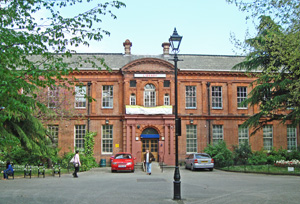
The former male wing of the Asylum is now Bethnal Green Library, located in the southwest corner of the site of the Asylum. The entrance was remodelled in the 1920s.
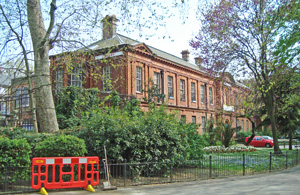
The northeast corner of the Library.
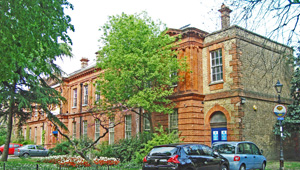
The southwest corner of the Library.
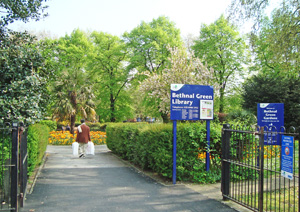
The entrance to the Bethnal Green Gardens and Library. In 1895 the LCC bought the land to the west of the Asylum and laid it out as public gardens. The Gardens are still known familiarly today as Barmy Park.
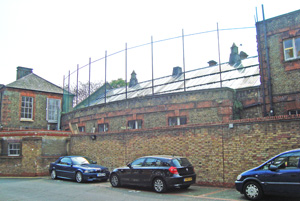
The back (above) and side (below) of the Library.
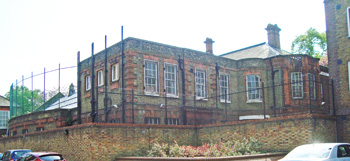
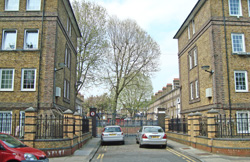
Apartment blocks of the Bethnal Green Estate on the western part of the site of the Asylum, to the east of the Library.
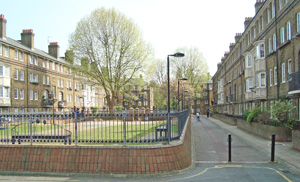
The Bethnal Green Estate (above and below) occupies the western part of the Asylum site.
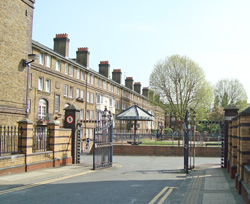
Andrews J, Scull A 2003 Customers and Patrons of the Mad-Trade: The Management of Lunacy in 18th Century London. Berkeley, University of California Press.
(Author unstated) 1832 Cholera. American Journal of the Medical Sciences, 11, 530-531.
(Author unstated) 1844 Report of the Metropolitan Commissioners in Lunacy to the Lord Chancellor. London, Houses of Parliament.
(Author unstated) 1882 Thirty-sixth Report of the Commissioners in Lunacy to the Lord Chancellor, Vol. 32. London, House of Commons.
Gordon D 2010 Little Book of the East End. Stroud, The History Press.
Inglis L 2003 Georgian London: Into the Streets. London, Viking.
Jones K 1995 Lunacy, Law and Conscience, 1744-1845: The Social History of the Care of the Insane. Abingdon, Routledge.
Mitford J 1825 Crimes and Horrors in the Interior of Warburton's Madhouses at Hoxton and Bethnal Green, vol. 2. London, Benbow.
Murphy E 2004 A mad house transformed: the lives and work of Charles James Beverly FRS (1788-1868) and John Warburton MD FRS (1795-1847). Notes and Records: the Royal Society Journal of the History of Science 58, 267-281.
Rogers JW 1816 A Statement of the Cruelties, Abuses and Frauds Practised in Mad-Houses. London, self-published.
http://edithsstreets.blogspot.co.uk
http://forum.casebook.org
http://hansard.millbanksystems.com (1) 1828
http://hansard.millbanksystems.com (2) 1889
http://history.beewarb.org
http://lookandlearn.com
http://studymore.org.uk
http://website.lineone.net
https://barmypark.wordpress.com
https://en.wikipedia.org
https://historicengland.org.uk
www.barryoneoff.co.uk
www.british-history.ac.uk (1) 1800
www.british-history.ac.uk (1) 1920s
www.eastlondonadvertiser.co.uk
www.flickr.com
www.history.ac.uk
www.historytoday.com (1)
www.historytoday.com (2)
www.londongardensonline.org.uk
Return to alphabetical list
Return to home page